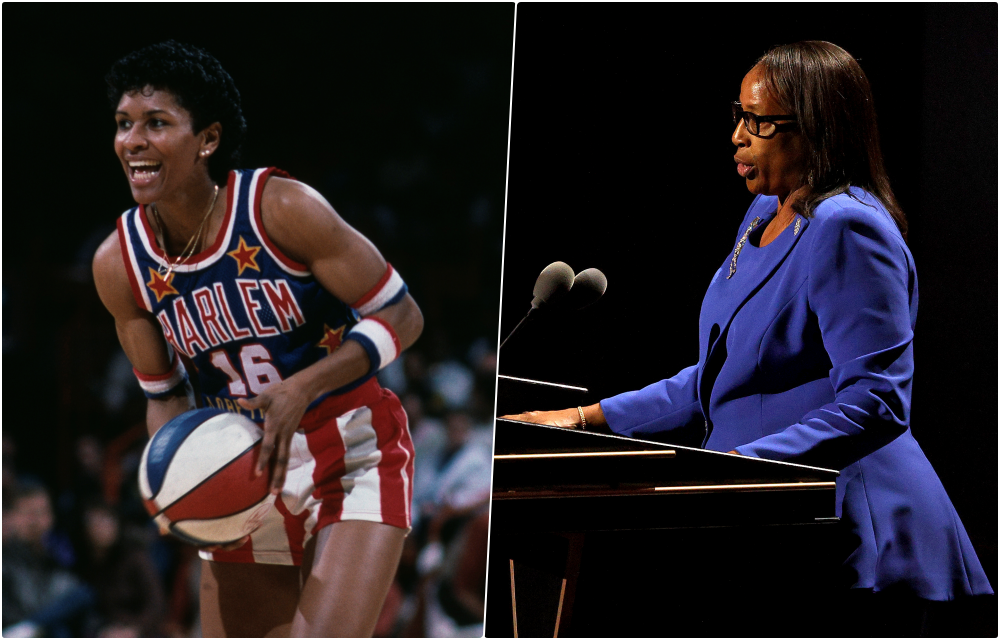The world of sports stopped Thursday night to watch and celebrate Iowa superstar guard Caitlin Clark as she broke Kelsey Plum’s record to become the all-time career leader in scoring for NCAA Division I women’s basketball.
Clark broke the record in style too, hitting a logo 3-pointer for the record-breaker. She finished the game with a career-best 49 points – setting the Hawkeyes’ single-game program scoring record – as Iowa beat Michigan.
When it comes to discussing the all-time women’s college basketball scoring record, the words “NCAA” and “Division I” are important qualifiers and delineations. Without them, they brush aside the significant accomplishments of at least two players that paved the way and poured in points long before Clark.
The names Lynette Woodard and Pearl Moore might come up when the game’s all-time greatest scorers are discussed. And if you’re a women’s basketball fan, you should know them, and know why they are often overlooked.
Woodard played at Kansas from 1977 to 1981. She was a four-time All-American and led the Jayhawks to three straight Big 8 titles in 1979, 1980 and 1981. And in her four seasons in Lawrence, Woodard scored 3,649 points.
You might be asking yourself, “Wait, isn’t that more than Plum or Clark?”
Yes, it is.

The NCAA does not recognize Woodard’s record because it did not govern women’s college basketball during her time at Kansas. From 1970 until the NCAA hosted its first Division I women’s basketball tournament in 1982, most women’s college basketball teams – and other women’s collegiate sports, like softball – played in the Association for Intercollegiate Athletics for Women (AIAW). The AIAW held its own tournaments and had its own record books for more than a decade before the NCAA entered the picture. In 1982, the AIAW Tournament lost much of its appeal when powerhouses at the time like Tennessee and Louisiana Tech opted to join the NCAA. Shortly after, NBC canceled the contract for the AIAW tournament, and the governing body dissolved.
Woodard went on to be the first woman signed to the Harlem Globetrotters, won an Olympic gold medal in 1984, and played two WNBA seasons in her late 30s. At the age of 39, she tallied 18 points, nine rebounds and three assists in a win for the Detroit Shock over the New York Liberty. She’s in the Basketball Hall of Fame and the Women’s Basketball Hall of Fame.
Clark could still pass Woodard’s mark. After Iowa’s win over Michigan, Clark is 81 points away from passing her. With Clark averaging 32.8 points per game this season, she could surpass Woodard as soon as a Feb. 28 game at Minnesota, the penultimate regular season game on Iowa’s schedule.
However, Pearl Moore’s mark might be out of reach for Clark, unless she decides to come back for a fifth season of college basketball next year.
Moore played at Francis Marion University, an institution with an enrollment of less than 5,000 students in Florence, South Carolina. In 127 games across four seasons for coach Sylvia Hatchell – who would coach the North Carolina Tar Heels to a national championship in 1994 – Moore scored 4,061 points, an absurd and staggering figure.
Again, that’s more than Clark, Plum and Woodard.
And again, Moore’s mark is often overlooked.
She also played during the reign of the AIAW and Francis Marion competed in the governing body’s “small college” division. After the AIAW dissolved, Francis Marion played as an NAIA school for a few years and is now an NCAA Division II program.
It’s also important to remember that Woodard and Moore – both guards who could shoot from distance – played in an era and piled up all those points during a time when the 3-point line did not exist.
In Moore’s final game, she scored 60 points against UT-Chattanooga. A four-time small college All-American, Moore went on to play in the WBL – the short-lived predecessor of the WNBA that folded in 1981 – and has been inducted into the Basketball Hall of Fame and the Women’s Basketball Hall of Fame.
Moore is a fan of Clark’s game, but she also wants to make sure that trailblazers like her are remembered. She recently told the Associated Press:
“She can lead her team, she can pass and she can score. Those are three key components to being a great player… Just tell those (TV) analysts to make sure they call it right.”
Woodard offered a similar sentiment in a widely released statement:
“In honoring Caitlin’s accomplishments, I hope that we can also shine a light on the pioneers who paved the way before her. Women’s basketball has a glorious history that predates the NCAA’s involvement. I applaud Caitlin for everything she has done and look forward to watching her score many more points for years to come.”
Indeed. Let’s celebrate Caitlin Clark, but also not omit the great players that came before her.
